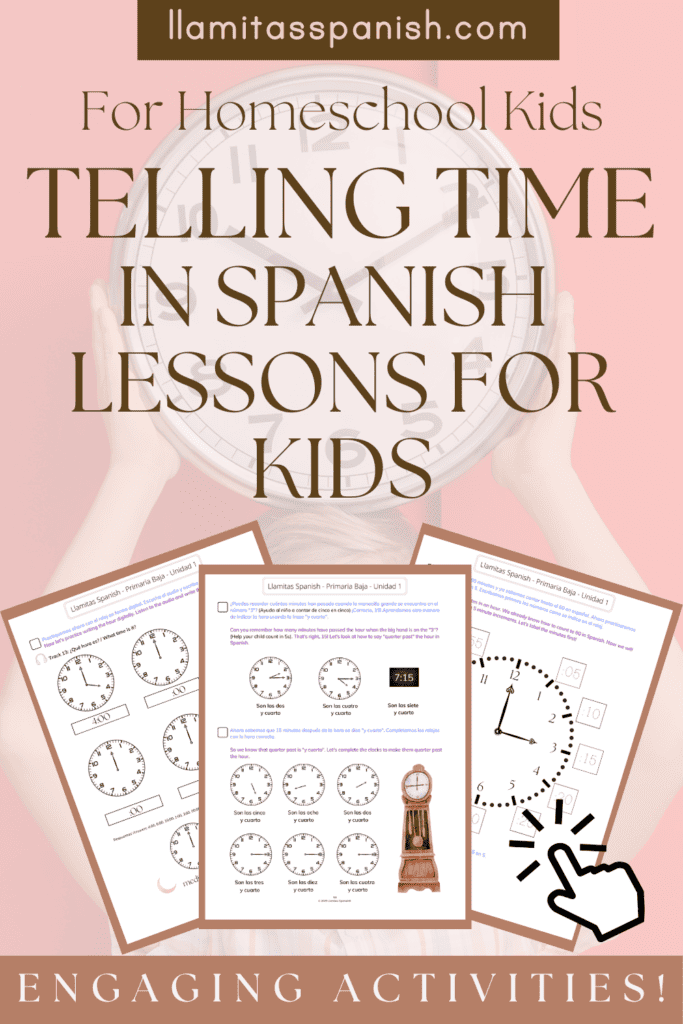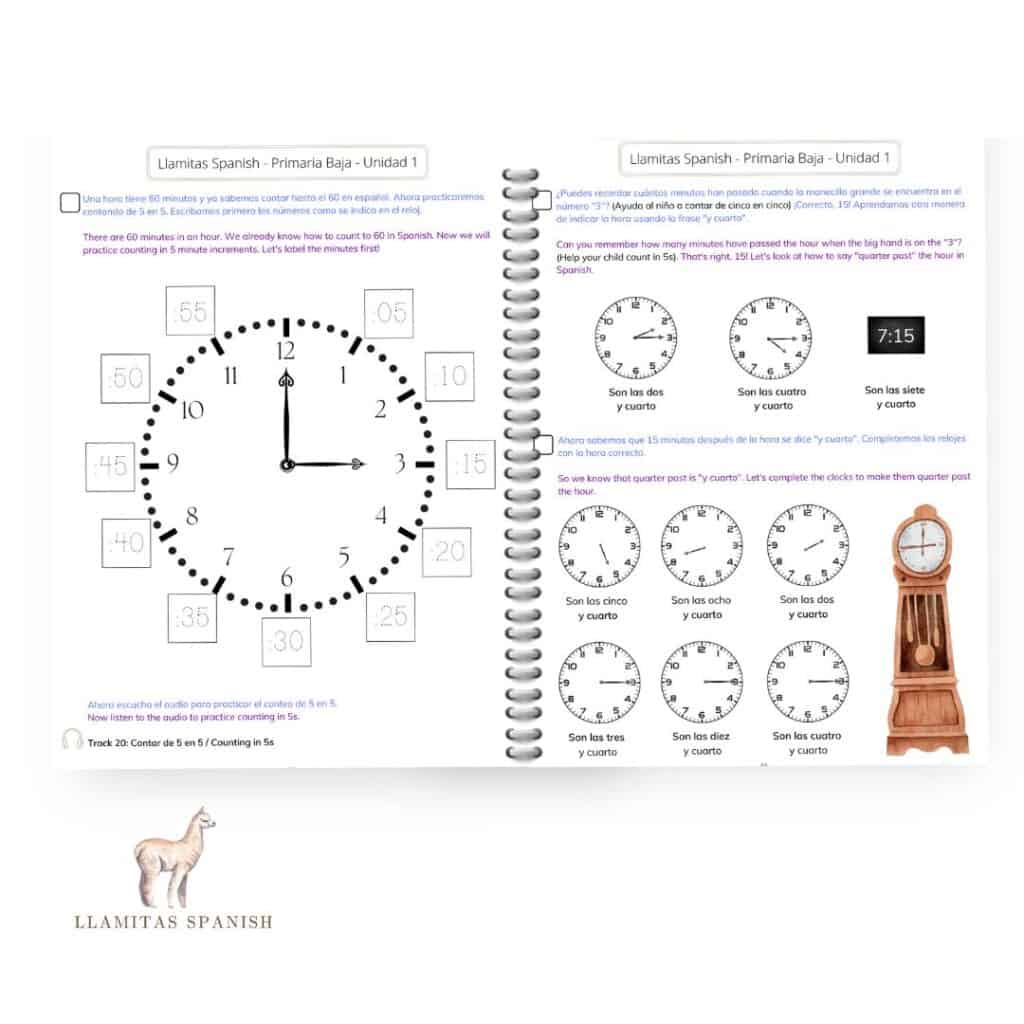In this post: Learn how to tell the time in Spanish and peek inside our Spanish curriculum lessons for learning the time.
One foundational elementary math skill is learning to tell the time. Even in today’s technology driven world, it’s still important to be able to read the time!
After building counting foundations in Level 1, Llamitas Spanish students are introduced to learning the time on the hour in Spanish in our Level 2 curriculum.
Then in Level 3, students learn how to tell the time in full. It’s taught in the context of the theme ‘Los animales nocturnos’ (nocturnal animals).

Asking the Time and Telling Time on The Hour
Ask the time in Spanish using the phrase, ¿Qué hora es? – What time is it?
To respond, we say ‘son las ….’ followed by the number for that hour except for 1 o’clock where we use ‘es la…’ because it’s singular.
To help you tell time on the hour, use the table below:
| Spanish | English |
| Es la una | It’s one o’clock |
| Son las dos | It’s two o’clock |
| Son las tres | It’s three o’clock |
| Son las cuatro | It’s four o’clock |
| Son las cinco | It’s five o’clock |
| Son las seis | It’s six o’clock |
| Son las siete | It’s seven o’clock |
| Son las ocho | It’s eight o’clock |
| Son las nueve | It’s nine o’clock |
| Son las diez | It’s ten o’clock |
| Son las once | It’s eleven o’clock |
| Son las doce | It’s twelve o’clock |
Students will even get to learn a fun ‘on the hour’ counting song in Level 2! Take a listen now!
| Spanish | English |
| Tic, tac, tic, tac Yo soy el Señor Reloj Tic, tac, tic, tac Doce horas toco yo. x2 A la una, como tuna. A las siete, un juguete. Tic, tac, tic, tac, |
Tick, tock, tick, tock I am Mr. Clock Tick, tock, tick, tock I pass by 12 hours. x2 At one o’clock, I eat tuna. Tick, tock, tick, tock, |
Expressing Quarter Past and Half Past in Spanish
To express that the time is half past the hour in Spanish, add the phrase ‘y media’. For example, half past 5/5:30 would be: Son las cinco y media
To express that the time is a quarter past the hour in Spanish, add the phrase ‘y cuarto’. For example, quarter past 3/3:15 would be: Son las tres y cuarto
Now challenge yourselves, how would you say 7:30 and 6:15?
Telling time can sometimes get confusing (even in English). Rest assured that this and every unit in our curriculum is designed to go in-depth while ensuring that your kids can follow along and enjoy different themes.
The use of numbers and basic mathematical concepts in this topic emphasizes the importance of learning the fundamentals in the early years and completing our level 1 curriculum before jumping into levels 2 and 3.
Related post: Counting in Spanish Made Easy
Telling the Time in 5-Minute Increments
Use the table given earlier along with the one below as quick reference guides to tell time in 5-minute increments. Feel free to get creative and make your own versions at home.
| Spanish | English |
| y cinco | 5 minutes past |
| y diez | 10 minutes past |
| y quince/y cuarto | 15 minutes past/quarter past |
| y veinte | 20 minutes past |
| y veinticinco | 25 minutes past |
| y treinta/y media | 30 minutes past/half past |
Now let’s take a look at a few examples:
- 2:20 – Son las dos y veinte
- 9:10 – Son las nueve y diez
- 1:25 – Es la una y veinticinco
Expressing Minutes to the Hour
When we start talking ‘minutes to’ the hour, that’s where things get a bit tricky as the structure is different than English. In Spanish, we start with the number of the upcoming hour, menos (less) the number of minutes until the minute hand gets to that hour.
For example:
2:45 – Son las tres menos quince (Literally: It’s 3 o’clock less 15 minutes)
That’s because the upcoming hour is 3 o’clock and there are 15 minutes left until the minute hand gets to that hour to make it 3 o’clock on the dot.
Take a look at another example:
6:45 – Son las siete menos quince (Literally: It’s 7 o’clock less 15 minutes)
Make your own clocks and practice at home using the table below:
| MINUTES TO (the hour) | |
| menos cinco | 5 minutes to |
| menos diez | 10 minutes to |
| menos quince/menos cuarto | 15 minutes to/quarter to |
| menos veinte | 20 minutes to |
| menos veinticinco | 25 minutes to |
Different ways to say ‘Quarter to’ the hour in Spanish
There are different variations of saying ’quarter to’ depending on which Spanish-speaking country you are in. The most common form ‘menos cuarto’ was mentioned previously and is used in Spain.
On the other hand, Mexico uses ‘cuarto para’ or ‘quince para’ which in English means ‘a quarter until’ or ‘15 minutes until’ respectively, and is used with the structure ‘Es un…’
For example,
2:45 – Es un cuarto para las tres (It’s quarter to 3)
6:45 – Es un cuarto para las siete (It’s quarter to 7)
Spanish Curriculum for Elementary
Our level one curriculum has taken your kids to space, the ocean and more while building a solid foundation for getting them closer to being bilingual. Now we’re taking it to the next level!
Expand their learning through even more themes with the structured open-and-go program of our Llamitas Spanish Curriculum: Levels 2 and 3.

Your kids will enjoy 6 thematic units and 6 authentic stories in each level, while learning lower elementary math, phonics, geography, history and much more.
If you’re ready for your kids to take the next step in their language learning journey, our series of elementary Spanish curriculum levels are waiting for you to explore!

